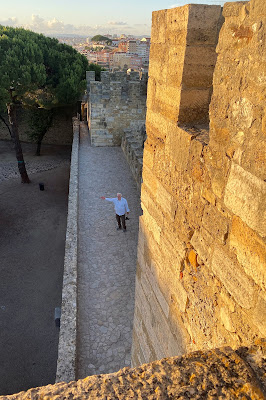June 22, 2022
Feeling fortified by an excellent seafood meal, we continued what had turned out to be a much more lengthy and difficult "walk" to the St. George Castle than we anticipated. Suddenly stops along the way to take in the view seemed unusually appealing. Of course, how could we say no to this view?
The large dome on the left is the Church of Santa Engrácia, one of the many churches we never made it to.
One of the building walls near the view area had this azulejo (glazed ceramic tile) depiction of Commerce Square, the large plaza facing the ocean we had seen at the beginning of our walk.
The bougainvillea was in bloom all over town. I'd like to copy this look in my backyard, right down to the real bird on the edge of the birdbath.
Still going uphill, we reached another large plaza with a large statue at the center.
The church you can see on the far left behind St. Vincent is the Monastery of São Vincente de Fora (or "St. Vincent Outside the Walls"). Unfortunately, we never made it to that church either.
Portugal is no place for someone in a wheelchair or with a walking disability. I've never walked up and down so many stairs anywhere, and there are no accommodations made for those who can't navigate the stairs.
So why two different doors? One for parents and one for kids? I love the color of the window and the punched fish design under the panes.
Of all the places we walked to in Lisbon, the St. George Castle was probably the farthest, and truly, it was almost all uphill. It was late afternoon by the time we finally arrived.
A couple of statues onsite: She's underdressed and he's overdressed. I don't know who she is, but he is Manuel I, the King of Portugal from 1495 to 1521. His nickname is O Venturoso, or "The Fortunate" because he was named heir to the throne by his brother-in-law, John II.
I was impressed by the array of peacocks strutting around the castle grounds. (Did you know a group of peafowl is called an "ostentation"?)
Up to this point we had been on the castle hill but not in the castle itself. Here we go!
The earliest walls and towers were built during the time the Moors occupied Lisbon during the 14th century. It was improved and enlarged over the centuries until the 1755 Lisbon earthquake left some of it in ruins. By the 1930s, it was almost obscured behind more recent structures, but restoration was ordered by Portugal's popular dictator, António Salazar, who was in power from 1933 to 1974.
Bob is so a-door-able.
I don't know what kind of tree this is, but it is HUGE. Look at the staircase on left for perspective.
There were several trees that caught my attention inside the castle walls. You can only appreciate how large this tree is . . .
. . . by watching this video.
I wanted to climb as high as I could. How often do you get to wander freely over a castle this size?
There's Bob on the left, waving at me from down below.
More magical passageways. I just can't resist.
It was definitely time to start the long walk back to our hotel. At least we knew it was all downhill.
I will I had a clothesline like this. Pretty practical, if you ask me.
Let's get a close-up of the tiles on the second story of this apartment building.
So amazing.
Down, down, down.
Note that few of these photos are taken on a city street with vehicular traffic. I'm glad we visited Lisbon in the GPS Era.
Back in our hotel, the hotel alarm went off three times. I went down to the lobby to see what was going on and discovered that they had a leak that had hit the electrical system, triggering the alarms in every room on the 4th floor--our floor. They had to dismantle the alarm, which was a bit disconcerting.
When we finally got to bed 30 hours after having left our home in the U.S., we slept soundly all night. We had logged 6,726 miles in the air and six miles on our feet during those hours, and neither one of us had gotten much sleep on the plane. The cure for jet lag and an eight-hour time change is to be completely exhausted when you finally go to bed in the new place. It works like a charm.



.JPG)

.JPG)



















.JPG)
.JPG)




.JPG)



.JPG)
















.JPG)


.JPG)
.JPG)

.JPG)

As crazy as it was to be walking up these hills and all over town after flying all day and all night, this was one of my favorite days. I loved where we ate, I loved the view from St. George Castle.
ReplyDelete